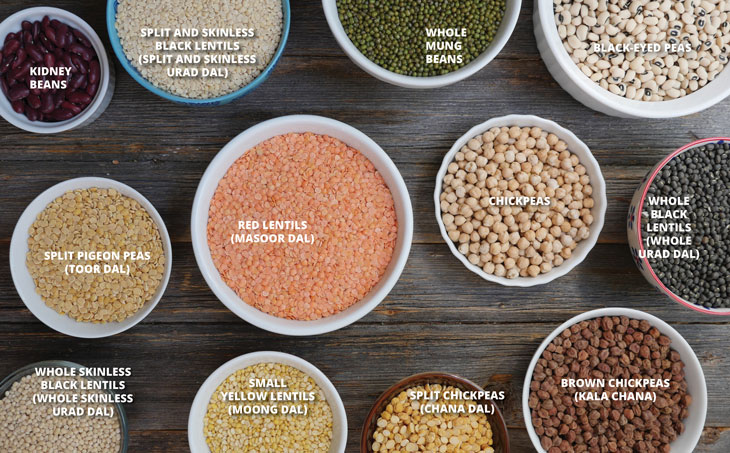More About Dal And Pulses Online
Wiki Article
4 Easy Facts About Dal And Pulses Online Explained
Table of ContentsFascination About Dal And Pulses OnlineThe Basic Principles Of Dal And Pulses Online The Single Strategy To Use For Dal And Pulses OnlineThings about Dal And Pulses OnlineHow Dal And Pulses Online can Save You Time, Stress, and Money.Unknown Facts About Dal And Pulses Online

While you can make a dal out of any type of pulse, typically, the word "dal" only shows up in the name of a pulse if it is a split lentil. For instance, chana dal = split chickpeas, whereas if I am referring to entire chickpeas, I would state chana or chole.

Fascination About Dal And Pulses Online
Okay before we reach it I need to connect my publication I have several different sorts of dal recipes in my cookbook which is readily available below: Indian Food Under Pressure (evidently I am additionally among those professors who uses her own publication in course and also refers to it usually) These brownish chickpeas are more nutty in flavor than garbanzo beans.When I initially began food preparation I discovered it really challenging to set apart in between several of the yellow lentils. And also there were additionally typical lentils, like red lentils, that I had no concept just how to use apart from in my lentil rangoli. Prior to I dive into some of my favorite pulses as well as the usual recipes I utilize them for, below is my short understanding of different pulses.
They are dried out vegetables that expand in a pod of one to twelve seeds. Consists of beans, lentils, peas, and also various other little seeds referred to as lentils or beans. Dal is frequently translated as "lentils" but in fact describes a split variation of a number of lentils, peas, chickpeas, kidney beans, as well as so on.
Dal And Pulses Online Fundamentals Explained
For example, split Mung beans are Mung daal. Indian pulses are normally available in three kinds: the entire pulse, the split pulse with the skin on, and also the split pulse with the skin got rid of. When babies are all set to eat strong foods they typically will begin with khichadi which is made with rice and a combination of lentils prepared very soft.I would certainly push prepare some rice with lentils, spinach or carrots, a little bit of turmeric extract, salt, and ghee as well as he would certainly gnaw! Khichdi is still one of our family members faves though now I make it far more delicious by including seasonings, ginger, garlic, as well as cumin, and also the lentils that go in differ.
The very best part concerning the entire masoor is that they are easily available in routine grocery store shops and create hearty brownish lentil curry. Split red lentils prepare very fast as well as make tasty yellow dal. I like utilizing them in my spinach dal dish too as they cook much faster and also are also lighter on the belly. These likewise come in the split and also de-skinned type yet I have not tried them. These are probably the most popular as well as usual beans after the chickpeas as well as can be found in many grocery store shops. These come canned as well as all set to utilize yet I favor acquiring the completely dry beans as well as saturating and then stress food preparation them similar to the various other beans - dal and pulses online.
The Only Guide for Dal And Pulses Online
I stay in New Jersey with my husband and also 2 kids.Before we delve right into the category of various kinds of of dals, allow us begin with some standard perspective regarding dal itself. Dal is a South Asian name for dried as well as split pulses (dal and pulses online).

Indicators on Dal And Pulses Online You Need To Know
Pulses are dried out bean seeds. They are expanded in hundreds of distinctive types throughout the world. Pulses originate from the Latin word puls, which refers to seeds made use of in making thick soup. Pulses have around 2-3 times the protein per serving of grain grains- rice, oats, barley, and wheat, making them an economical resource of plant-based healthy protein.The taste of black-eyed peas stands out, as well as they are a staple in Indian food. Curries, dals, papads, and also fritters are all made using them. The black gram referred to as urad is a black seed with a white inside. In size and appearance, it looks like a mung bean, however it has a various taste.
Green peas are linked here small as well as spherical when whole. They are generally offered boiling or steaming. They have a sweet taste as well as a starchy appearance that advises me of yellow peas. Matki (Turkish-Dew Gram Beans) are a nutty-flavored bean with an earthy taste. Moth bean is another name for this plant.
Facts About Dal And Pulses Online Uncovered
Masoor dal is a popular recipe in Northern India with a lovely natural taste. Dal, soups, and stews are some of the dishes prepared from it.Report this wiki page